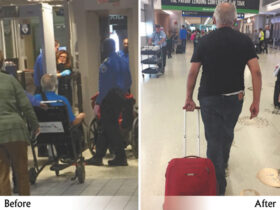Understanding and Treating Puncture Wounds of the Foot
By Joe Altepeter, DPM
 We’ve all had that moment—walking barefoot through the kitchen, across the beach, or in the garden—when suddenly, zap! A jolt of pain shoots through your foot. You freeze, wondering, “What did I just step on?” Was it something harmless, like a Lego or dog toy? Or something more dangerous—glass, a rusty nail, a jagged shell, or a splintered piece of wood?
We’ve all had that moment—walking barefoot through the kitchen, across the beach, or in the garden—when suddenly, zap! A jolt of pain shoots through your foot. You freeze, wondering, “What did I just step on?” Was it something harmless, like a Lego or dog toy? Or something more dangerous—glass, a rusty nail, a jagged shell, or a splintered piece of wood?
Sometimes the pain is immediate and obvious. Other times, it’s subtle. You may remember some discomfort that seemed to pass, only to notice later a stain on your sock or a red, irritated spot on your foot. That’s when it hits you: “Maybe I really did step on something after all.”
These scenarios often result in a puncture wound—a small, but potentially serious injury caused by a sharp object piercing the skin. Unlike cuts, puncture wounds are narrow and deep. Because the entry point is small, it often closes quickly, trapping bacteria—or pieces of the object—inside.
Why Puncture Wounds Matter
If you’re lucky, the object might come out cleanly without further problems. But sometimes fragments remain embedded in the foot. This is especially risky if the object was dirty or contaminated.
People with reduced sensation—such as those with diabetes or neuropathy—are especially at risk. Without the ability to feel pain properly, they may not realize they’ve been injured and continue to walk on the wound, worsening it.
If left untreated, a puncture wound can lead to infection, abscesses, or even deeper issues involving joints or bone. What starts as a small nuisance can escalate into a serious health concern.
When to Seek Help
Always seek medical attention after a puncture wound, even if it seems minor. Warning signs that should never be ignored include:
• Ongoing or worsening pain
• Redness or swelling, especially if spreading
• Pus or other drainage
• Bleeding that won’t stop
• Trouble walking or putting weight on the foot
• Fever or chills
• Seeing part of the object still in the skin
These signs suggest infection or retained material—both of which need prompt treatment. A podiatrist or other medical provider can help evaluate the injury and offer appropriate care.
What Happens at the Doctor’s Office
Your provider will review your medical history and examine your foot. X-rays are often used to check for foreign objects. However, not all materials show on standard X-rays—wood, for example, can be hard to detect—so ultrasound or MRI might be needed.
If the object is close to the surface, it might be removed in the office. If it’s deeper or there’s infection, surgery could be necessary. If signs of infection are present, a culture swab may be taken to guide antibiotic treatment.
And don’t forget about tetanus. If you were injured by a rusty or dirty object and haven’t had a booster recently, a tetanus shot may be recommended.
Prevention Is the Best Cure
While you can’t always avoid accidents, wearing the right footwear greatly reduces your risk. This means:
• Water shoes at the beach, pool, or lake
• Sturdy work boots on job sites
• Supportive slippers or house shoes at home
This is especially important for people with numbness in their feet. Without normal sensation, even a small wound can go unnoticed and untreated.
When in Doubt, Get It Checked Out
It’s tempting to brush off a puncture wound as no big deal—but these injuries can become serious quickly if not handled properly. Even if the object came out and the pain has gone away, seeing a medical professional is wise.
If you’re unsure what to do, don’t hesitate to contact your podiatrist. Prompt care can prevent infection, complications, and even the need for surgery. Your feet carry you everywhere—keep them protected and pain-free.
Disclaimer: This content is not intended to be a substitute for professional medical advice, diagnosis, or treatment. Always seek the advice of your physician or other qualified health care provider with any questions you may have regarding a medical condition.
Joe Altepeter, DPM, AACFAS, is a Podiatrist at Family Foot & Leg Centers in Fort Myers FL. He is a Fellow of the American College of Foot & Ankle Surgeons. Call 239-430-3668 or visit www.NaplesPodiatrist.com to make an appointment. Visit FootHealthFacts.org to learn more about foot and ankle conditions.
1645 Colonial Blvd.
Fort Myers, FL 33907
(239) 430 – 3668 (FOOT)
NaplesPodiatrist.com






